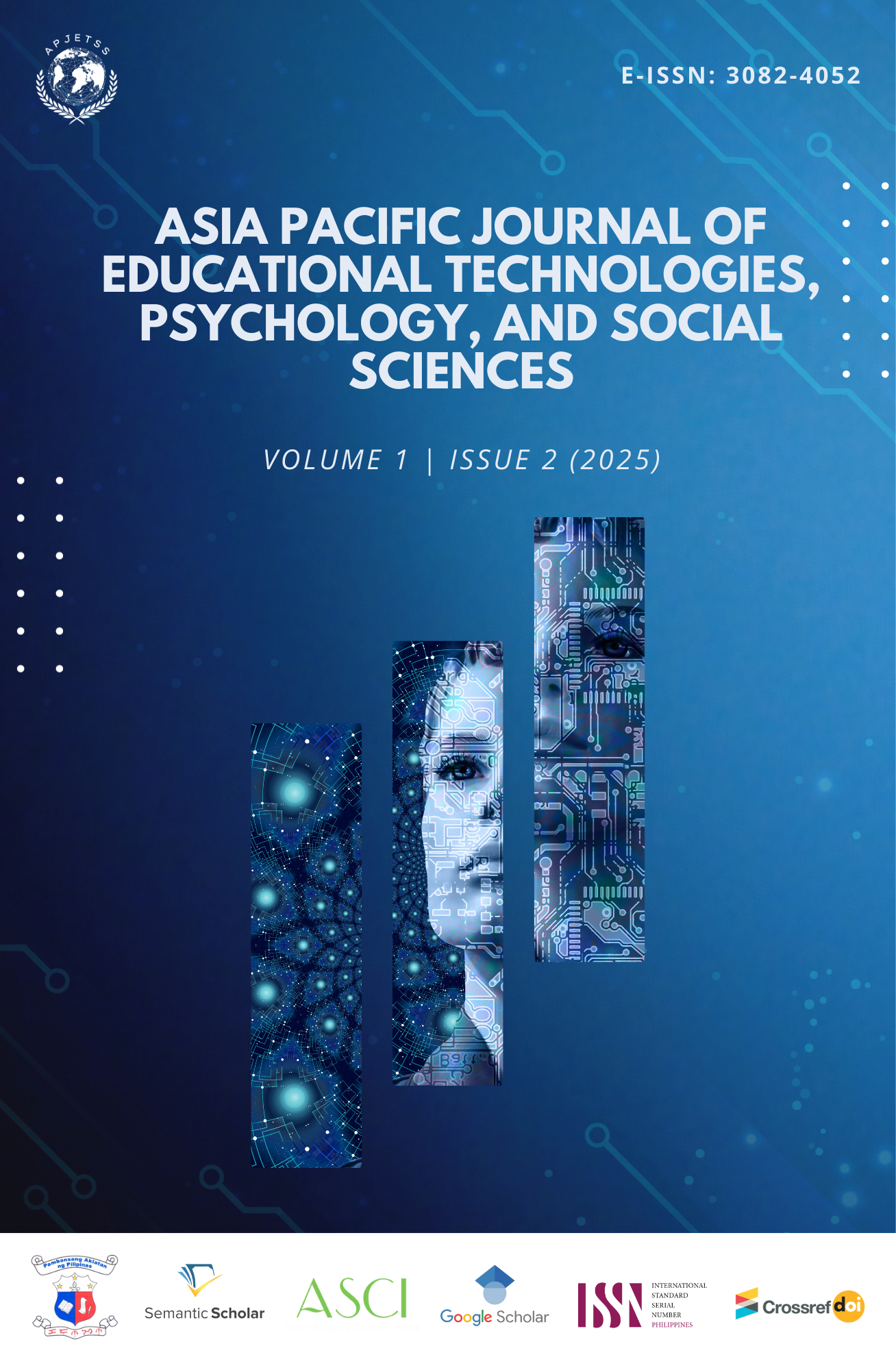Disaster Preparedness Among Households in a High-Risk Philippine City: A Descriptive-Causal Analysis
Main Article Content
Abstract
Kidapawan City, situated in a disaster-prone area of the Philippines, has repeatedly experienced natural hazards such as earthquakes, flash floods, and droughts. This study assessed the disaster preparedness of 200 households across ten high-risk barangays, using a descriptive-causal research design. Data were gathered through a validated, structured questionnaire and analyzed using descriptive statistics and logistic regression. Findings revealed that earthquakes were the most frequently experienced and severe disasters, with significant impacts on infrastructure and livelihoods. Households demonstrated a high level of preparedness, particularly in communication planning, evacuation awareness, and securing essential documents. However, preparedness for specific hazards like flooding remained low due to economic and logistical constraints. Trust in the City Disaster Risk Reduction and Management Council (CDRRMC) was notably high and positively correlated with household preparedness, alongside education level, marital status, perceived severity of disasters, and quality of interventions received. The study recommends enhancing community engagement, aligning institutional priorities with localized needs, and strengthening risk communication through trusted and accessible channels. Results underscore the critical role of socio-demographic and institutional factors in shaping disaster readiness and advancing community resilience strategies.
Article Details

This work is licensed under a Creative Commons Attribution 4.0 International License.
Copyright © 2024 APJETPS, its licensors, and contributors. All rights are reserved. For all open access content, the Creative Commons (CC) Attribution 4.0 International Public License terms apply.
References
Abosuliman, S.S., Kumar, A., & Alam, F. (2013). Disaster preparedness and management in Saudi Arabia: An empirical investigation. International Journal of Social, Human Science and Engineering, 7(12), 295-299.
Abulnour, A. (2014). The post-disaster temporary dwelling: Fundamentals of provision, design and construction. HBRC Journal, 10(1), 10-24. https://doi.org/10.1016/j.hbrcj.2013.06.001
Bonfanti, R. C., Oberti, B., Ravazzoli, E., Rinaldi, A., Ruggieri, S., & Schimmenti, A. (2023). The Role of Trust in Disaster Risk Reduction: A Critical review. International Journal of Environmental Research and Public Health, 21(1), 29. https://doi.org/10.3390/ijerph21010029
de Corcuera, L.N., Barrera, M.D., Hidalgo, A.C., & Martinez, J.R. (2022). Assessment of the adequacy of mobile applications for disaster reduction. Environment Development and Sustainability,24(5), 6197-6223. doi:10.1007/s10668-021-01697-2
Domingo, S. N., & Manejar, A. J. A. (2018). Disaster preparedness and local governance in the Philippines (No. 2018-52). PIDS Discussion Paper Series.
Endo, A. (2018). Introduction: Human-environmental security in the Asia-pacific ring of fire: water-energy-food nexus. In The Water-energy-food Nexus (pp 3-17). Springer, Singapore.
Espina, E. (2015). A Social Cognitive Approach to Disaster Preparedness. Retrieved May 22, 2024, from https://www.pap.ph/assets/files/journals/
Fisher, M. J., & Marshall, A. P. (2009). Understanding descriptive statistics. Australian Critical Care, 22(2), 93-97.
Jeziorski, A., Keller, B., Dyer, R. D., Paterson, A. M., & Smol, J. P. (2015). Differences among modern-day and historical cladoceran communities from the “Ring of Fire” lake region of Northern Ontario: Identifying responses to climate warming. Fundamental and Applied Limnology, 186, 203-216.
Kannadhasan, Suriyan, Guruprasath, R., Shanmuganantham, M., & Ramalingam, Nagarajan. (2021). Study and exposure to Natural disaster for world cities. International Journal for Scientific Research & Development, 8(11), 374-377.
Kaur, P., Stoltzfus, J., & Yellapu, V. (2018). Descriptive statistics. International Journal of Academic Medicine, 4(1), 60.
Kim, Y., & Kim, M. Y. (2022). Factors affecting household disaster preparedness in South Korea. PLoS ONE, 17(10), e0275540. https://doi.org/10.1371/journal.pone.0275540
Kunz, N., Reiner, G., & Gold, S. (2014). Investing in disaster management capabilities versus pre-positioning inventory: A new approach to disaster preparedness. International Journal of Production Economics, 157, 261-272.
Lagsa, B. (2019). Beyond repair: Dread and anxiety in Kidapawan after strong earthquakes.https://www.rappler.com/nation/243983-cotabato-earthquake-victims-seek-help-november-2019/
Nick, T. G. (2007). Descriptive statistics. Topics in Biostatistics, 33-52.
Oregon Natural Hazards Workgroup. (2007). Households Natural hazards preparedness survey. Community Service Center. 1209 University of Oregon Eugene, OR 97403-1209
Paul, J.D., Bee, E., & Budimer, M. (2021). Mobile phone technologies for disaster risk reduction. Climate Risk Management, 32(4).
Shamkhi, A N., & Ebraheem, M A. (2020). Disaster and crises management strategy. https://doi.org/10.1088/1757-899X/737/1/012184
Spitzig, A. (2019). Laying the groundwork for a community risk assessment of the Ring of Fire and Related Infrastructure. http://hdl.han dle.net/10315/36373
Taherdoost, Hamed. (2016). Validity and reliability of the research instrument: How to test the validation of a questionnaire/survey in a research. International Journal of Academic Research in Management, 5(3), 28-36.
United Nations Office for Disaster Risk Reduction (UNDRR). (2019). Global assessment report on disaster risk reduction, Geneva, Switzerland, United Nations Office for Disaster Risk Reduction (UNDRR). https://gar.unisdr.org/sites/default/files/reports/2019-05/full_gar_report.pdf
United Nations Office for Disaster Risk Reduction (UNDRR). (2019). The 2018 annual report. Geneva, Switzerland, United Nations Office for Disaster Risk Reduction (UNDRR). https://reliefweb.int/report/world/unisdr-annual-report-2018
Unson, J. (2016). Drought-affected farmers block Kidapawan City highway to demand relief. https://www.philstar.com/nation/2016/03/30/ 1567636/drought-affected-farmers-block-kidapawan-city-highway-demand-relief
Villanueva, Aileen A., & Villanueva, Paquito M. (2017). Awareness and disaster preparedness of barangay disaster risk reduction and management committees (BDRRMCs) of Laur, Nueva Ecija, Philippines. International Journal of Advanced Research (IJAR).doi: 10.21474/IJAR01/5886
Yin, Q., Ntim-Amo, G., Ran, R., Xu, D., Ansah, S., Hu, J., & Tang, H. (2021). Flood disaster risk perception and urban households’ flood disaster preparedness: The case of Accra Metropolis in Ghana. Water, 13(17), 2328. https://doi.org/10.3390/w13172328
Zamboni, L. M., & Martin, E. G. (2020). Association of US households’ disaster preparedness with socioeconomic characteristics, composition, and region. JAMA Network Open, 3(4), e206881-e206881.
Zhang, F., Bao, X., Deng, X., Wang, W., Song, J., & Xu, D. (2022). Does trust help to improve residents’ perceptions of the efficacy of disaster preparedness? Evidence from Wenchuan and Lushan earthquakes in Sichuan Province, China. International Journal of Environmental Research and Public Health, 19(8), 4515.

